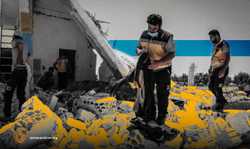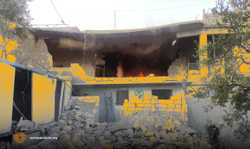Investigations
The Use of Krasnopol Weapon Systems in Syria
December 14, 2022Two investigations show the use of Krasnopol weapon systems to target civilian infrastructure in Syria
Print Article
In mid to late 2021, a Syrian Civil Defence Centre and a medical facility were hit by projectiles launched from a Krasnopol artillery weapon system. These attacks occurred in June and September 2021 and restricted access to first responders and medical assistance in areas already in desperate need of support. The attacks detailed in this report severely limited first responder capacities, killed and wounded civilians, as well as damaged civilian homes.Findings in this report suggest that Syrian and Russian government forces stationed in Idlib’s southern countryside are responsible for the incident. Findings show that the forces likely used a weapon system named ‘Krasnopol’ that often uses lasers—in combination with a drone—to identify and attack its target.
According to Rosobornexport, Russia’s state weapons exporter, the 152 mm 2K25 ‘Krasnopol’ artillery weapon system is “designed to engage tanks and other armoured vehicles, artillery pieces, both moving (at speeds up to 36 km/h) and stationary, exposed and sheltered, as well as dugouts, bridges, and crossings”. The 2K25 system includes the 3OF-39
‘Krasnopol’ laser-guided projectile (the projectile likely used in the attacks detailed in this report), which features a high-explosive fragmentation (HE-FRAG) warhead; a laser target designator; and the 1A35 shot synchronisation system. The last two components help with target acquisition, guidance, and control. This guidance provides the distinct advantage of allowing an artillery unit to fire at individual targets – such as a vehicle – precisely without necessitating the greater expenditure of ammunition, wider area effects, and increased time-on-target associated with an artillery barrage. Several variations of the original 3OF-39 projectile exist as a result of subsequent improvements: the ‘Krasnopol’-M 152-mm, the ‘Krasnopol’-155 (KM-1), and the ‘Krasnopol’-M 155-mm (KM-2). With all variants considered, the 3OF-39-series of projectiles can be fired by a wide variety of artillery guns and howitzers. All ‘Krasnopol’ munitions have a range of around 20 kilometres (with the KM-2 showing some variation based on gun tube length and charge configuration). At a range of 10–12 kilometres they can accurately hit a target without user input of meteorological data. The 3OF-39 projectile contains 6.5 kg of explosives in a 20.5 kg warhead.
The effect of such a projectile’s detonation can be quantified approximately using risk estimate distances (REDs). REDs are defined as the minimum distance friendly troops can approach the effects of friendly fire without suffering appreciable casualties of 0.1 per cent PI (one person in one thousand likely to be incapacitated; RED 0.1) or 10 per cent PI (one person in ten likely to be incapacitated; RED 10). For a projectile with physical characteristics similar to the 3OF-39, the RED 0.1 is around 400 m, and the RED 10 is around 100 m. Thus, lying in the prone position 100 meters away from where a 3OF-39-series projectile detonates, would result in an approximate 10% chance of being incapacitated.
The ‘Krasnopol’ projectiles described in this report—the 3OF-39-series projectiles— have been employed in Syria on a number of occasions. According to a Syrian Network for Human Rights September 2021 report, the 3OF-39-series projectile is a munition used “extensively in the Jabal Al Zaweya area and its vicinity in Idlib suburbs.” As Syrian Archive has described in a previous investigation, Sputnik Arabic published an article in February 2020 reportedly showing Syrian soldiers with a 3OF-39 Krasnopol projectile. In its article, Sputnik reports that the possible use of Krasnopol projectiles was announced in Syria at the end of the summer in 2016 and was shown to be used in November 2017.
The usage of a ‘Krasnopol’ weapons system suggests a direct targeting of the Civil Defence centre and medical facility by Syrian and Russian government forces, resulting in serious harm to civilians in the Idlib countryside.

